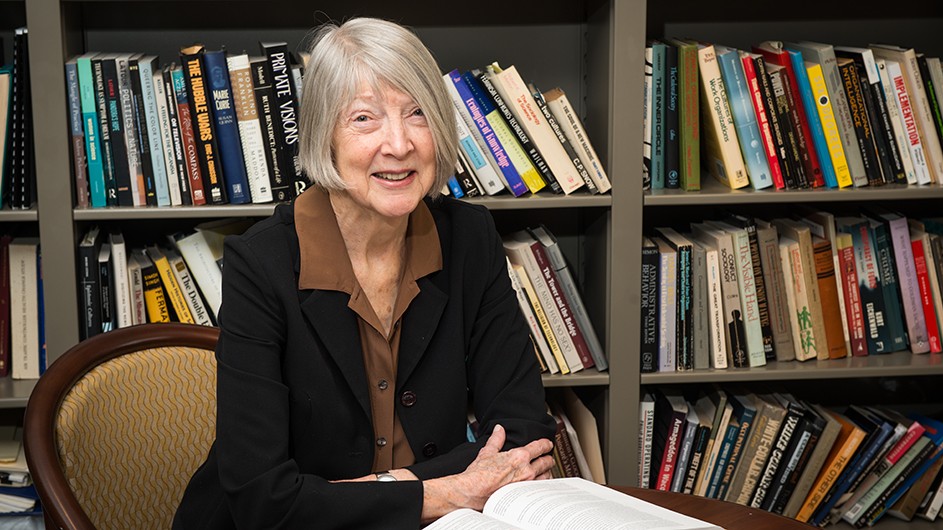The Complex World of Air Traffic Controllers
In “Dead Reckoning,” Sociology Professor Diane Vaughan looks at the effort it takes for controllers to keep the skies safe.

When two airplanes were flown into the World Trade Center towers on September 11, 2001, Americans watched in shock as first responders struggled to react to the situation on the ground. At the same time, another feat was taking place in the sky: More than 650 air traffic control facilities across the country coordinated their efforts to ground 4,000 flights in just two hours—an achievement all the more impressive considering the unprecedented nature of the task.
In Dead Reckoning: Air Traffic Control, System Effects, and Risk, Sociology Professor Diane Vaughan explores the complex, stressful work of air traffic controllers, work that is built upon a close relationship between human organizational systems and technology, and is remarkably safe given the high level of risk. She explains how the job demands coordination, collaboration, and focus—along with problem-solving solutions.
Vaughan discusses the book with Columbia News, and explains why air traffic controller is a job that will likely never be replaced by technology.
Q. How did this book come about?
A. I had written three books on how things go wrong in organizations: Controlling Unlawful Organizational Behavior, Uncoupling, and The Challenger Launch Decision. Despite variation in size, complexity, and function, the books had a common pattern of early warning signs that were either missed, misinterpreted, or ignored until after some harmful outcome.
Air traffic control came next: A large, socio-technical system where people are trained to recognize anomalies early and fix them, so little mistakes don’t turn into catastrophes. In 2000, I began the fieldwork—ethnography and interviews—in four air traffic control facilities in New England. My starting questions were: What makes this system so safe, or is it? What do air traffic controllers do that technology can’t replace? I had in mind an article or two.
I left the field in June 2001. Then, on September 11, the two planes hijacked out of Boston’s Logan Airport that were driven into the Twin Towers were handled by three of my four facilities. September 11 changed everything for them, and for me, because I understood how the past enabled controllers nationwide to accomplish the unprecedented feat of clearing the sky of all airplanes in less than two hours and 15 minutes, and I saw the impact of history on the system that day and after.
The book is about institutional persistence, change, and agency, and the connections between culture and cognition.

Q. Why is air traffic controller a role that technology will likely never be able to replace?
A. Controllers supply the dead reckoning, which consists of interpretive work: boundary work and ethnocognition. Controllers do two kinds of boundary work: They move airplanes across invisible boundaries in the sky that keep planes from colliding. To do this, they must also move airplanes across system boundaries on the ground, from controller to controller. But this is not easy, because every airspace is different. Passing planes from one controller to another is a continuing negotiation of conflicts because of variation in airspace. Boundary work calls for interpretive work, produced during their intensive training, which includes an apprentice system working live traffic in which a trainer refines their cognitive and physical skills—visual and hearing (“Listen to how he said that, now watch, he won’t be able to do what you just asked.”) that with repetition becomes embodied, so they respond automatically, without thinking, freeing them up to notice anomalies and correct them early.
The training and repetition on the job transform controllers. Ethnocognition refers to their shared cultural system of knowledge, which enables coordination across boundaries. Moreover, because of their experience at improvising standardized changes to fit the local situation (“How can we make this work here?”), they are skilled at repair in response to the liabilities of technological and organizational innovation.
I returned to the field in 2017, because the system had been automated, and controllers had moved into a newly designed consolidated facility that interfered with dead reckoning. Despite automation, they still worked in a system riddled with variation. Controllers were engaged in repair, trying to change physical, symbolic, cultural, and social boundaries to correct inequalities in skill, interpretive work, competence, and salary to restore what had been lost in the transition.
Q. What’s your favorite book no one else has heard of?
A. Essays on Interpretation in Social Science by Georg Simmel (translated by Guy Oakes). Simmel has been foundational to my thinking and methodology. The book consists of several essays. The first is about how an event becomes history; the second, about historical time; and the third about constitutive concepts of history. Woven into all of them are Simmel’s theory of social forms, the concept of culture, and his theory of interpretation.
Q. What’s the last great book you read?
A. The Secret Scripture by Sebastian Barry, the Irish novelist, playwright, and poet, named Irish Laureate of Fiction for his beautiful, compelling writing. Part of a historical trilogy, each about an individual from a different generation of the McNulty family, Scripture involves a 90-year-old woman in a hospital for the criminally insane that is bound for destruction. Her doctor, while trying to find her identity to place her elsewhere, unravels her history of poverty, isolation, and marginality as a young woman.
Q. You’re hosting a dinner party. Which three academics or scholars, dead or alive, would you invite and why?
A. I am interested in context, history, cognition, and creativity, or how people seemingly pull ideas out of the air who, when pushed, can trace the origin. So, Toni Morrison, Stephen J. Gould, and Paul Simon.